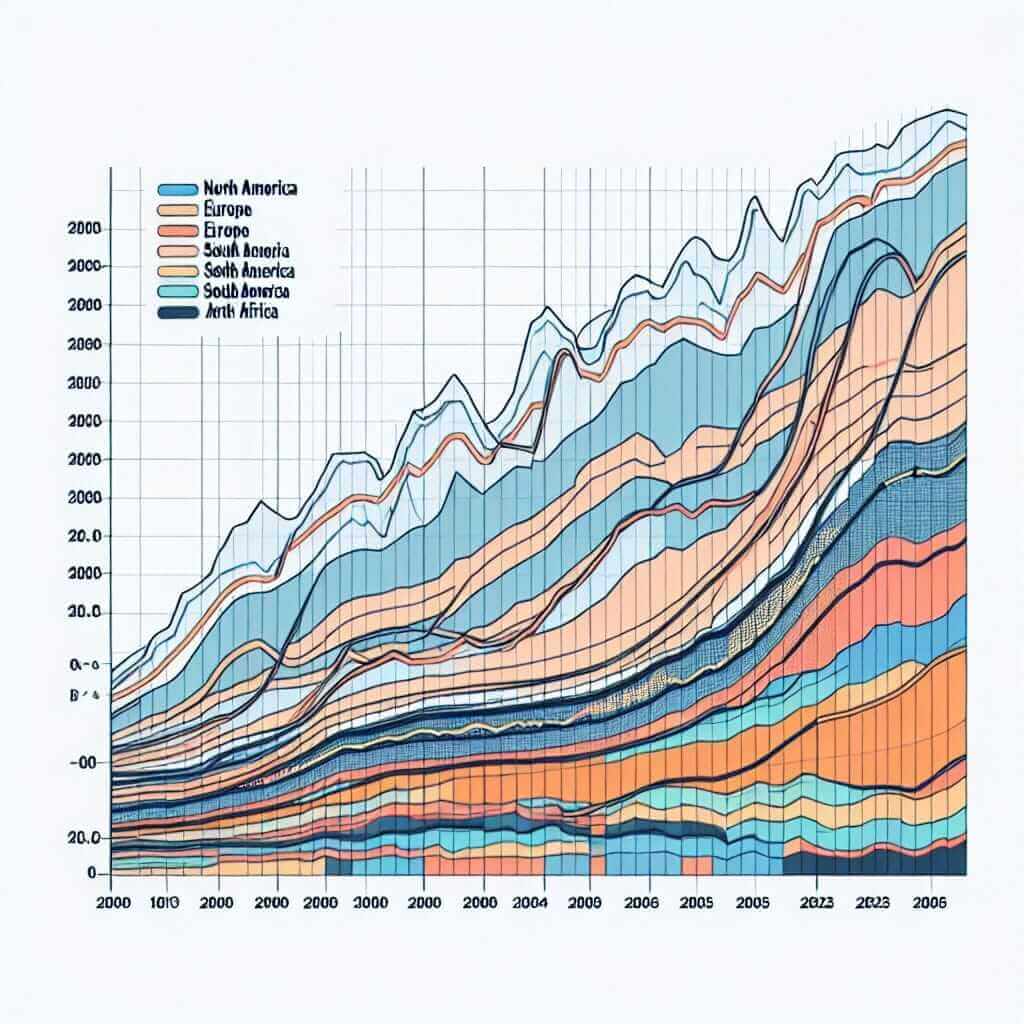Understanding and comparing levels of renewable energy investments in different regions from 2000 to 2023 is crucial in today’s context of combating climate change. The topic is highly relevant and often appears in IELTS Writing Task 1, especially under question types related to data interpretation from graphs, charts, and tables. This article will introduce hypothetical IELTS tasks based on this subject, followed by a detailed breakdown of tasks, writing samples, and tips for achieving a high band score.
Let’s get started with analyzing some hypothetical IELTS Writing Task 1 prompts related to “Comparing Levels of Renewable Energy Investments in Different Regions (2000-2023).”
Example Task Prompts
-
Task Prompt 1: The bar chart below shows levels of renewable energy investments in five different regions (namely North America, Europe, Asia, South America, and Africa) from 2000 to 2023. Summarize the information by selecting and reporting the main features, and make comparisons where relevant.
-
Task Prompt 2: The line graph illustrates the trends in renewable energy investments in different regions (North America, Europe, Asia, South America, and Africa) over the period from 2000 to 2023. Summarize the information by selecting and reporting the main features, and make comparisons where relevant.
-
Task Prompt 3: The table below shows the amount of investment in renewable energy (in billion dollars) for different regions (North America, Europe, Asia, South America, and Africa) in selected years from 2000 to 2023. Summarize the information by selecting and reporting the main features, and make comparisons where relevant.
Choosing and Analyzing the Task
Let’s select Task Prompt 2 for our detailed analysis and writing sample.
Data Interpretation
Below is a hypothetical line graph illustrating the trends in renewable energy investments in five different regions from 2000 to 2023.
[Insert Line Graph Here]

- X-axis: Years (2000 to 2023)
- Y-axis: Investment in Billion Dollars
- Distinct lines representing North America, Europe, Asia, South America, Africa
Analyzing the Task
Key Features to Notice:
- Overall trend: Increasing or decreasing investments over time.
- Peaks and troughs for specific regions.
- Significant differences in investment levels between regions.
- Any notable intersections or divergences in trends.
Writing a Sample Response
Introduction
The line graph presents trends in renewable energy investments across five regions—North America, Europe, Asia, South America, and Africa—over the period from 2000 to 2023.
Overview
Overall, investment in renewable energy has demonstrated an upward trend in all regions. Notably, Europe and Asia have seen the most significant growth, while Africa’s investment levels remain relatively low throughout the period.
Body Paragraphs
Details
In 2000, North America and Europe both had similar investment levels at around 10 billion dollars. However, Europe experienced a steady increase, reaching approximately 70 billion dollars by 2023, making it the region with the highest investment.
Asia showed significant growth, starting at 5 billion dollars in 2000 and soaring to 60 billion dollars by the end of the period. This rapid increase has made Asia the second-leading region in terms of investment by 2023.
North America, despite an increase, experienced more fluctuating trends. After peaking at about 50 billion dollars in 2017, it slightly declined to 45 billion dollars by 2023.
South America and Africa had the lowest levels of investment. South America improved modestly from 2 billion to 15 billion dollars, while Africa saw a negligible increase from 1 billion to 5 billion dollars over the 23-year span.
Word Count: 197
Tips for Writing Task
Vocabulary and Grammar Tips
Vocabulary:
- Investment (n): The act of putting money into a project or business to earn a profit.
- Fluctuate (v): To rise and fall irregularly.
- Negligible (adj): So small or unimportant as to be not worth considering.
- Peak (n/v): To reach the highest point.
- Upward/Downward trend (n): A general direction in which something is developing or changing.
Grammar:
- Use varied sentence structures: Simple, compound, and complex sentences.
- Ensure subject-verb agreement and correct use of tenses.
- Utilize comparative and superlative forms to make comparisons (e.g., higher, the highest).
Key Points to Remember
- Focus on significant trends and comparisons.
- Use precise data from the graph to support your descriptions.
- Maintain a clear structure: introduction, overview, and detailed paragraphs.
- Keep your language formal and academic—avoid conversational language.
Challenging Vocabulary to Remember
- Investment /ɪnˈvɛstmənt/ (n): The act of allocating resources, typically money, with the expectation of generating income or profit.
- Fluctuate /ˈflʌktʃueɪt/ (v): Move or sway in a rising and falling pattern.
- Negligible /ˈnɛɡlɪdʒəbl/ (adj): So small or insignificant as to be unlikely to matter.
- Peak /piːk/ (n/v): The highest point, either in physical terms or metaphorically.
- Trend /trɛnd/ (n): A general direction in which something is developing or changing.
- Significant /sɪɡˈnɪfɪkənt/ (adj): Sufficiently great or important to be worthy of attention.
Conclusion
To effectively tackle IELTS Academic Writing Task 1, ensure you understand the overall trends and key data points. Providing clear, concise comparative analysis is paramount. Regular practice and a good grasp of relevant vocabulary and grammar structures will help you aim for a high band score.